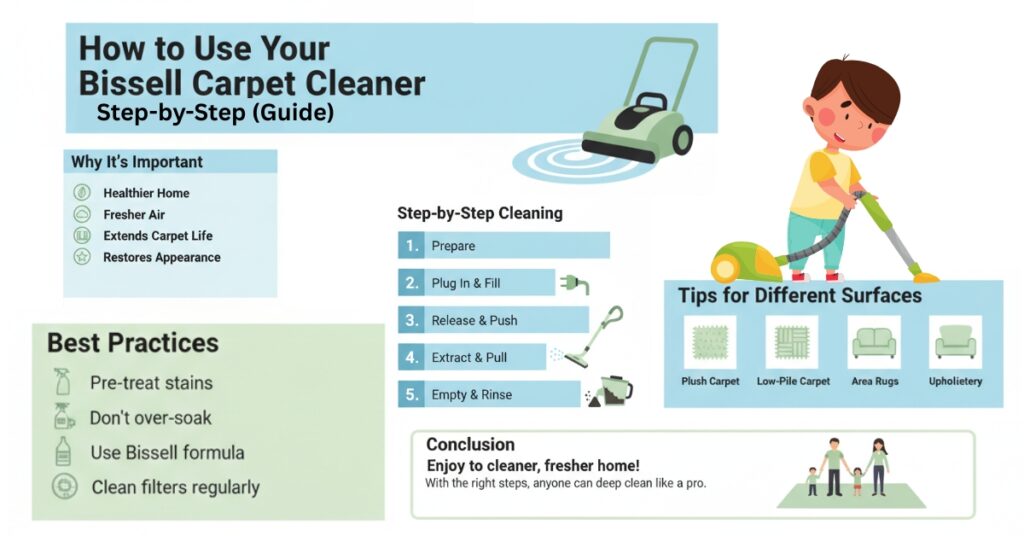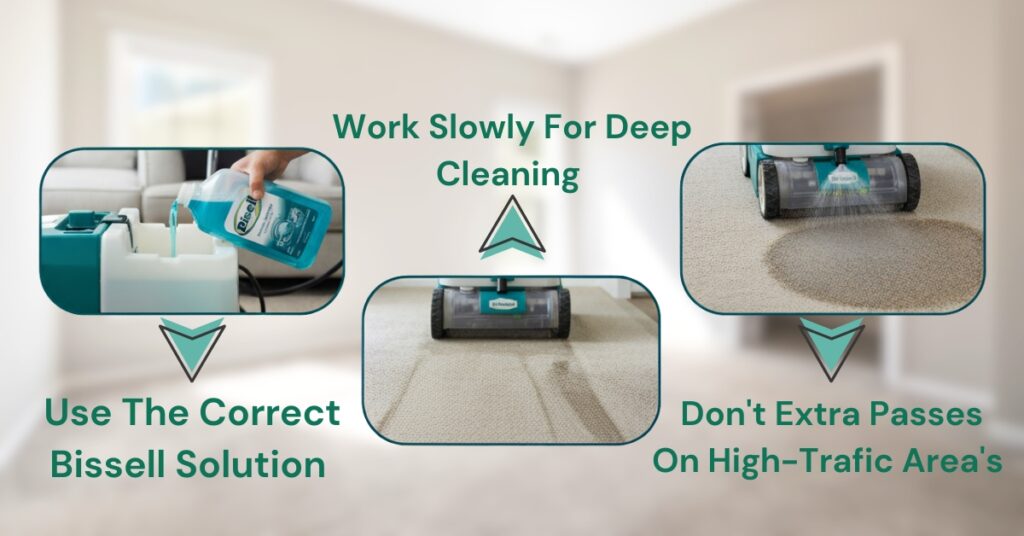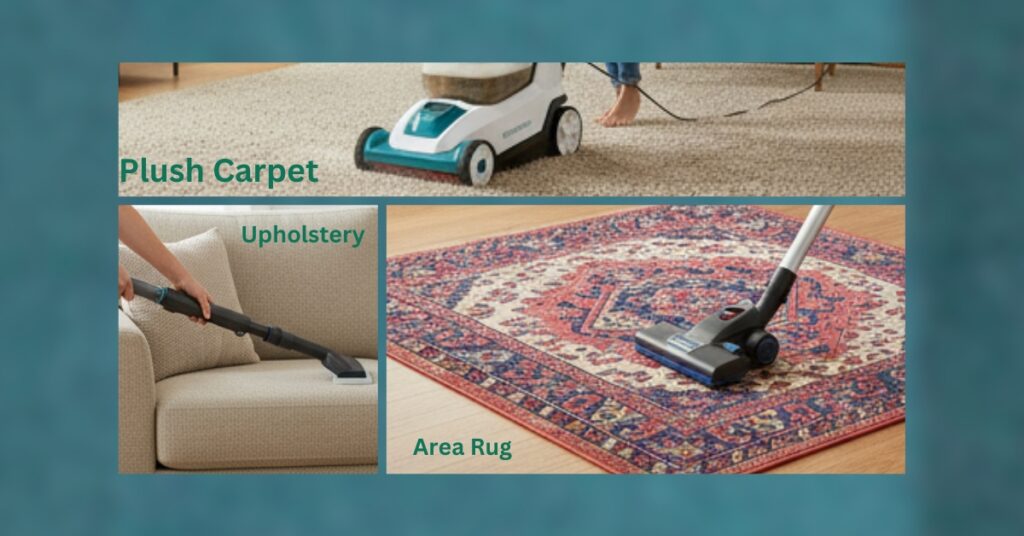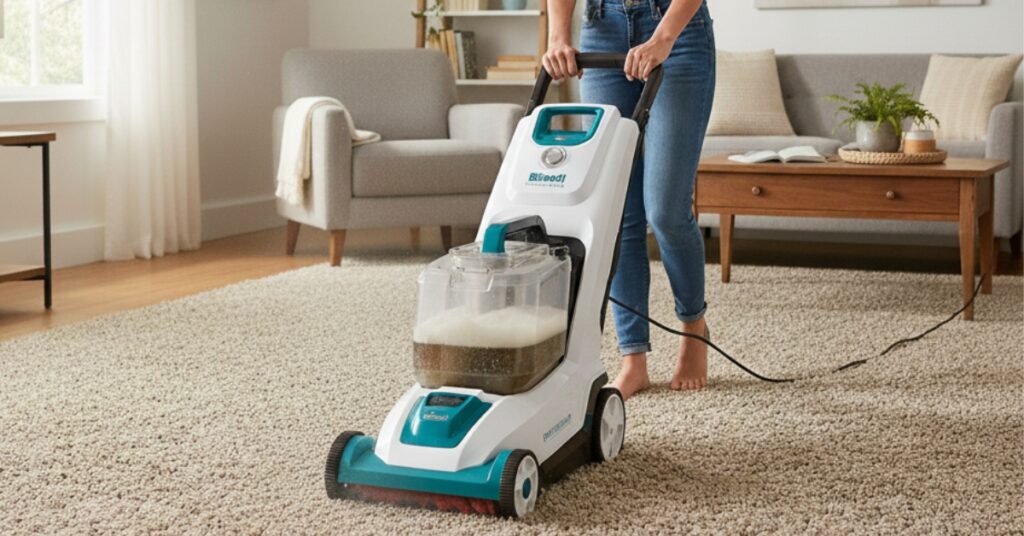As an Amazon Associate, I earn from qualifying purchases.

Your carpet goes through a lot of mud, spills, pet messes, and daily wear. While vacuuming helps with surface dirt, deep cleaning is essential to remove embedded grime and stubborn stains. That’s where your Bissell carpet cleaner comes in.
Using hot water, cleaning solution, and powerful suction, bissell carpet cleaners can extract dirt from deep within carpet fibers. With the right technique and preparation, you can achieve professional-level results at home. This guide will show you how to use your Bissell effectively for spotless, refreshed carpets.
Content Topic
Why It’s Important to Use a Carpet Cleaner Properly

Understanding the importance of proper carpet cleaning technique goes beyond achieving spotless floors; it’s about protecting your financial commitment and fostering a more wellness-oriented home atmosphere.
Extends Carpet Lifespan
Carpets represent a significant financial investment, often costing thousands of dollars to replace. Deep-seated dirt acts like sandpaper on carpet fibers, causing premature wear and fading. When you use your bissell carpet cleaner correctly, you can remove abrasive particles that would otherwise grind against the carpet backing with each step. This preventive maintenance can extend your carpet’s life by several years.
Removes Hidden Contaminants
Surface cleaning only addresses what you can see. Beneath the visible layer, carpets harbor dust mites, microorganisms, animal fur, and allergens that frequent vacuuming cannot eliminate. Proper deep cleaning with your Bissell carpet cleaner eliminates these contaminants, creating a cleaner environment for your family. This is particularly crucial for households with allergies, asthma, or young children who spend time playing on carpeted floors.
Remove Deep Dirt, Stains, and Allergens
Stains and dirt don’t just sit on the surface; they sink deep into your carpets, making them hard to remove. Deep cleaning penetrates fibers to lift stubborn stains, grime, and allergens. Achieve a fresher, healthier home with thorough carpet care.
- Stubborn Stains from Spills and Accidents: Spills, pet accidents, and splashes can leave deep stains and odors in carpets if untreated. Bissell carpet cleaners tackle these tough spots by applying cleaning solution directly, scrubbing fibers with powerful brushes, and lifting stains to restore your carpet’s original look.
- Tracked-In Dirt and Mud: Shoes, paws, and foot traffic bring dirt and mud into your home, which gets embedded in carpets over time, making them look dirty and worn. Regular vacuuming only removes dirt from surface, but a bissell carpet cleaner uses powerful suction and brushes to deep clean carpets, extending their lifespan.
- Dust Mites, Pollen, Pet Dander & Hidden Allergens: Rugs can hold allergens such as dust mites, pollen, and pet dander, which may affect your health, especially if you have allergies or asthma. Vacuuming often stirs them up instead of removing them. A Bissell carpet cleaner uses hot water, cleaning solution, and suction to eliminate these allergens, making your carpets safer and healthier.
Improves Indoor Air Quality
Dirty carpets act as reservoirs for airborne pollutants. Every time someone walks across the carpet, these particles become airborne again, contributing to poor indoor air quality. When you follow proper cleaning procedures, you remove these trapped pollutants, resulting in fresher, cleaner air throughout your home.
Delivers Cost-Effective Results
Professional carpet cleaning services typically charge $0.20 to $0.40 per square foot, making it expensive to maintain large carpeted areas. Learning how to operate your Bissell carpet cleaner effectively allows you to achieve similar results at a fraction of the cost. Over time, this skill can save hundreds or even thousands of dollars in professional cleaning fees.
How to Use a Bissell Carpet Cleaner (Step-by-Step)

Mastering the art of carpet cleaning requires attention to detail and following a systematic approach. These step-by-step instructions for the bissell little green carpet cleaner and larger models will help you achieve professional-quality results.
Step 1: Prepare the Room
Prepare the space before cleaning your carpet. Remove loose dirt and move furniture to ensure an even, hassle-free clean.
- Clear the Floor: Remove as much furniture as possible to create an open space for easier carpet cleaning. For heavy items like sofas or bookshelves, clean around them and place plastic sheets or foil under the feet to avoid damage.
- Vacuum Thoroughly: Vacuum the carpet first to remove dirt, dust, and pet hair. Skipping this step can clog your carpet cleaner and reduce its effectiveness. A quick vacuum allows the cleaner to work deeper and deliver better results.
Step 2: Fill the Clean Water Tank and Add Cleaning Formula
Your bissell carpet cleaner has two separate tanks: one for clean water and cleaning solution, and another for collecting dirty water. Proper setup of the clean water tank with the right balance of water and cleaning product is crucial for effective carpet cleaning. This ensures optimal performance and a thorough clean.
- Remove the Clean Water Tank: Locate the clean water tank on your Bissell machine, usually on the back or top. Press the release latches or lift it straight up to remove. Hold it upright to avoid spills.
- Fill with Hot Tap Water: Open the tank lid and fill it with hot (not boiling) tap water up to the fill line. Avoid overfilling to prevent leaks and maintain efficiency. Hot water helps the cleaning formula work better on tough dirt and stains.
- Add Bissell Cleaning Formula: Add the recommended amount of Bissell cleaning solution to the water tank, using the tank’s markings as a guide. Do not use other soaps or detergents, as they can damage your machine or leave residue on your carpet. Always refer to your specific model’s instructions for exact measurements.
Step 3: Power On and Begin Cleaning
Get your space prepped and your cleaning solution ready; it’s time to tackle the mess. Set up everything, and you’re just a few steps away from a spotless finish. Here’s how :
- Plug In and Power On: Connect the machine to a nearby power socket and press the power button to turn it on.
- Clean with Forward and Backward Passes: Begin at the farthest corner of the room. Press the handle button to spray the solution as you push the cleaner forward, then release the button and pull it back to collect the dirty moisture. Overlap sections slightly to ensure complete coverage.
Step 4: Empty the Dirty Water Tank
Keep your cleaner running smoothly by managing the dirty water tank. Regularly emptying it prevents overflow and improves performance. Perfect for tackling larger cleaning tasks.
- Monitor the Tank: The machine’s suction decreases as the dirty water tank fills. Most Bissell models have a float that activates when the tank is full, changing the motor’s sound to signal it’s time to empty the tank.
- Remove and Empty: First, turn off and unplug your machine. Remove the dirty water tank carefully from the front. Empty its dirty water into a sink or toilet. You’ll be surprised by the amount of dirt collected.
- Rinse and Replace: Rinse the dirty water tank, refill the clean water tank, and reattach the dirty tank to the machine. You’re ready for the next cleaning session.
Step 5: Allow Carpets to Dry Properly
After cleaning, dry the area thoroughly to prevent mold and mildew, which can damage belongings and affect health. Use fans, open windows, or a dehumidifier to speed up the drying process. Proper drying keeps your home fresh, clean, and safe.
- Ventilate the Room: To maintain a fresh and dry home, open the windows and turn on a fan. A portable fan can help circulate the air, which aids in quickly drying out any moisture and preventing mold growth. If you have a dehumidifier, this is the perfect time to use it.
- Perform a “Dry” Pass (Optional): After cleaning, you can perform a “dry pass” without spraying any solution. It allows the machine to suck up any remaining moisture, helping the carpet dry faster, preventing it from staying damp for too long. And making the floor ready for use more quickly. While it’s not always essential, taking this step can lead to quicker results.
- Wait Before Replacing Furniture: After cleaning your carpet, let it dry thoroughly before placing furniture back. Drying usually takes 4–12 hours, depending on carpet thickness, weather, and humidity. Moving furniture too soon can trap moisture, cause stains, or damage the carpet. During this time, limit foot traffic so the fibers can settle properly and stay clean.
Best Practices for Effective Carpet Cleaning

Carpet cleaning isn’t just about following the steps—it’s about doing it smartly. Simple habits like using the right formula and proper drying can make a big difference. Here are some tips for achieving professional-level results!
- Use the Correct Bissell Solution: Bissell designs specific cleaning formulas for their machines. Using unapproved detergents can lead to excessive foam, motor damage, or sticky residue that attracts more dirt. Always use the correct Bissell formula; they offer specialized options, such as pet odor removal or harsh stain treatments. Choose the right one for your needs.
- Work Slowly: Rushing is a common mistake. Moving the machine too fast prevents brushes from loosening deep dirt and suction from entirely removing dirty water. This leaves hidden grime. Work slowly and steadily so the brushes and suction can clean thoroughly, leaving your carpet fresh. Patience improves the final result.
- Don’t Oversaturate the Carpets: Oversaturating carpets can lead to longer drying times and may cause mold or mildew to develop. Utilize only the amount of cleaning solution necessary to clean effectively. without soaking the fibers.
- Do Extra Passes on High-Traffic Areas: High-traffic areas, such as hallways, entryways, and spaces near sofas, collect the most dirt and dust. To keep them clean, make an extra wet pass to loosen grime and an additional dry pass to remove moisture and dirt. This prevents stains and keeps carpets looking fresh longer.
- Focus on High-Traffic Areas: High-traffic areas like hallways, entryways, and living rooms collect more dirt. Clean these spots twice, using extra cleaning solution if needed.
Tips for Different Carpet Types and Surfaces

Bissell cleaners are incredibly versatile, working on carpets, rugs, upholstery, and even hard floors. With the right approach, you can tackle every surface with ease. Follow this quick guide for safe and effective cleaning.
1. Plush Carpets
Plush carpets feel great underfoot, but their thick fibers can trap a lot of dirt. This makes them challenging to clean. Follow these tips to get them spotless.
- Go Slow: For thick carpets, move the cleaner slowly to allow deep dirt and moisture extraction. Thicker carpets need more time per section for thorough cleaning.
- Multiple Dry Passes: Make extra dry passes without spraying to remove more water from carpet fibers. This helps carpets dry faster and stay fresher.
2. Low-Pile Carpets
Low-pile carpets are popular for high-traffic areas due to their easy maintenance. Their short fibers are less prone to trapping dirt and moisture.
- Standard Technique: To clean low-pile carpets, move your cleaner slowly forward to spray and loosen dirt, then pull it back to absorb water and debris. Steady, even motions ensure thorough cleaning and quick drying.
- Quick Drying: Low-pile carpets dry quickly, usually in a few hours, due to their short fibers and efficient water release. This means you can often return furniture or walk on the carpet the same day.
3. Area Rugs
Refresh your area rugs with your Bissell, but don’t forget a few key precautions. Follow these tips to clean safely and effectively!
- Test for Colourfastness: Test a hidden rug area first to check for color bleeding or fading before cleaning.
- Protect the Floor: If cleaning on hardwood or laminate, move the rug to a waterproof area. Alternatively, place a tarp underneath to prevent any moisture damage.
4. Upholstery Cleaning with Attachments
Keep your spaces spotless with tools like the “Little Green” cleaner. Perfect for tackling stairs, furniture, and car carpets with ease!
- Attach the Hose: Connect the hose to the machine’s port near the water tank. Push until it clicks for a secure fit. Ensure the machine is unplugged before starting.
- Spray and Scrub: Spray cleaning solution onto the cloth, then gently scrub the area with the brush. Work in small sections for best results.
- Suction the Dirt: Slowly glide the handheld tool over the surface to remove dirt and moisture. Clean small sections at a time for even drying.
Key Takeaways on How to Use a Bissell Carpet Cleaner

To perform a deep clean for your carpets at home, a Bissell carpet cleaner is an excellent tool. Begin by preparing the area, moving furniture, and vacuuming any loose dirt. When operating the cleaner, apply gentle yet firm pressure to ensure the cleaning solution and suction effectively penetrate carpet fibers.
After cleaning, allow the carpet to dry completely before replacing furniture or walking on it. Following these steps will help you eliminate tough stains and deep-seated dirt, refreshing your indoor air quality. Investing in a Bissell carpet cleaner is wise, as regular cleaning extends carpet life and maintains a fresh appearance.
Frequently Asked Questions
How often should I use my Bissell carpet cleaner?
Between six and twelve months is the ideal time to use your bissell carpet cleaner. Maintaining a schedule prolongs the life of carpets and keeps them fresh. Households with children or pet’s benefit from cleaning every three to six months to get rid of filth, allergies, and stains before they become permanent.
Can I use regular detergent in a Bissell carpet cleaner?
No, you should not use regular detergent in a Bissell carpet cleaner. Laundry and dish detergents create too much foam which causes clog and damage for the pump of your machine, it leaves sticky residue that attracts more dirt and may void the warranty. Always use a Bissell-approved carpet cleaning formula for safe and effective results.
How long does it take for carpets to dry after cleaning?
Typically, 6–12 hours for carpets to dry after cleaning. Most carpets dry within hours with good ventilation and low humidity. Heavier carpets or high humidity can extend drying to 24 hours. Using fans, opening windows, or running the air conditioner speeds up drying and prevents musty odors.
Can Bissell cleaners remove pet stains and odors?
Yes, Bissell cleaners can effectively remove pet stains and odors. Bissell machines, especially with pet-specific formulas, effectively break down and lift pet messes while neutralizing odors. Their strong suction helps prevent stains and leaves carpets fresher and cleaner.
Do I need to vacuum before using a Bissell carpet cleaner?
Yes, you should. Vacuuming eliminates loose hair, dirt, and debris by allowing the cleaner to focus on deep grime and preventing clogs. When you skip this step, it can lead to a less effective clean and strain the machine.
As an Amazon Associate, I earn from qualifying purchases.
